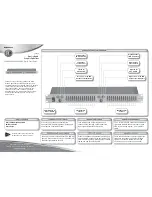
INTERNAL GAIN STAGING
In both versions, 18dB headroom (at least) is guaranteed and above that level IMD/ALI-
ASING/CLIPPING artifacts may drastically increase depending on the DRIVE and MOJO
settings.
Use the DRIVE option to adjust the internal gainstaging for the three stateful saturators within
a range of +/-9dB. The absolute headroom is also controlled via the MOJO option, by an
amount of 9dB.
The metering should give a rough indication if you are using the right version in a specific
situation: There should be some needle movement in the grey section of the scale. Also, avoid
continuous RMS levels in the red area.
2.5. METERING AND BALLISTICS
Metering is individually provided for the incoming and outgoing audio. Each meter has a
screw in the middle to obtain different ballistics. Each screw can be turned around by 360
degrees. The left screw controls the right one also. The right screw can be turned independ-
ently. This design allows both, turning them in sync or adjusting them differently.
In left most position the meter acts as a classic VU meter with 300ms integration time. Above
this setting, 'K-weighting' loudness filtering is activated and the integration time continuously
increases up to 3 seconds. Given this design, two other important settings can easily be
obtained:
1. In
one o'clock
position which is the plug-ins default position in all presets (it slightly
snaps into this position and one could also simply use
<ctrl> + mouse left click
to get
there) the metering accords to the so-called
momentary loudness
using a window of
400ms as specified by the ITU-R BS.1770-2 standard
2. In the fully clockwise (right most) position the metering accords to the so called
short-
term loudness
using a window of 3sec as specified by the ITU-R BS.1770-2 standard
1 including the proposed filtering and no gate
2 dito
11
Содержание ThrillseekerXTC
Страница 1: ...ThrillseekerXTC MANU AL revision 1 0 ...



























